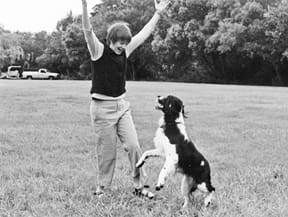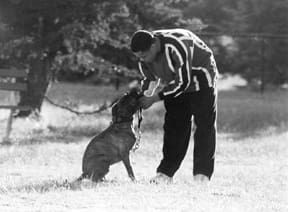By Mardi Richmond
When it comes to learning to come when called, not all dogs are created equal. Some dogs learn the “recall” very easily. They seem to know instinctively that coming when called is to their advantage. Others will come when called most of the time, perhaps more reluctantly.
For some dogs, however, coming when called is the most challenging behavior they will ever learn – especially when faced with choosing between complying with the request and distractions like squirrels, cats, balls, or other dogs.

But if your dog is having trouble learning to come, don’t despair. Teaching a dog to come when called (also known as the “recall”) is not as difficult as you may think. It takes time, enthusiasm, and lots of practice, but even the most reluctant dog can a reliable recall in most situations.
Getting started
In brief, for your dog to have a reliable recall, you will need to follow these steps:
• Teach your dog the initial behaviors (coming when called is really a series, or chain, of behaviors).
• Make your dog think coming when called is the best thing that happens in life.
• Practice, practice, practice.
• Increase distractions gradually, so that your dog learns that coming to you is always more rewarding than anything else.
• Continue reinforcing (with variable rewards) for life.
Begin your recall training by thinking about what you would like the behavior to look like. Have a clear picture in mind so that you know what you will be working toward.
My picture is this: When I say, “Jesse, come!” I want my dog to immediately disengage from the activity she is doing, race toward me at full speed, and plop herself into the sit position in front of me. I want her to stay sitting until I snap on the leash, give her another behavior to do, or release her back to play.
Most trainers recommend that your dog’s recall is followed by a sit or a collar touch, to help keep him from immediately racing away after coming.
Once you have the chain of behaviors in mind, pick the word or hand signal you’d like to use. “Come” is a good choice, but you could use any word. If you have unsuccessfully tried to teach a recall before, use a different cue word this time around. “Here” and “front” are good alternatives.
While this article focuses on an everyday “Come,” most people expect several variations of the behavior from their dogs. For example, some people have a casual behavior like, “C’mon, let’s go!” and a formal obedience “Come,” too. If you train each of these with its own cue, you can help your dog know exactly what is expected.
Chain, chain, chain
Because coming when called is actually a chain of behaviors, it works best to teach each part of the chain separately first.
Please note: Always use the highest value rewards when teaching “Come.” Try chicken, liver, cheese, sardines, and other smelly, yummy, soft treats. From the start, make recall practice the highlight of your dog’s day.
• Charge up the cue. This simple step will give you a head start on the rest of the training. Go into a low stimulation environment where you and the dog can be alone (like the bathroom or bedroom). Say the word you have chosen for your cue (in these examples, we’ll use the word, “Come!”) and then give your dog a treat. Repeat this 10 to 20 times. Do this exercise several times over two or three days. You are essentially supercharging the cue.
• Teach your dog the beginning behavior by capturing it, using a food lure, or both. To “capture” the behavior, simply set your dog up for success. When your dog is about to come to you anyway (what trainers call “offering” the behavior), say “Come!” just before he gets to you, then use your reward marker (in most cases, a click! of a clicker or the word “Yes!,”) and give your dog a reward.
For example, you can say “Come!” when your dog is on his way to you to get his dinner, when you are about to go for a walk, or when you are getting ready to toss his favorite ball.
If you want to use a treat lure to get started, simply put the treat in front of your dog’s nose, as he sniffs it, take several steps backward. When he follows the treat toward you, click or say “Yes!” and give him the treat. Repeat this several times.
Once your dog will easily follow the treat, add the cue “Come!” It’s important to quickly “fade” or eliminate the treat lure, going to a click and treat as soon as possible. Practice in your living room, bedroom, backyard, and other low-stimulation environments.
• Practice the “quick turn” and “sit” on (leashed) walks. Surprise your dog on your walks by suddenly calling him and taking several steps back. When he turns to follow, click or say “Yes!” and give him a treat. Tell him what a great dog he is!
After a couple of practices, add in the sit and/or a collar touch. For example, say, “Jesse, come, sit!” With a few dozen repetitions most dogs will begin automatically sitting.
• Increase the distance and speed. If you have practiced a recall only across the length of your living room, don’t expect your dog to be able to come from a distance of the length of a park or field. You’ll need to practice with gradually increasing distances first.
Start by just calling him a few feet, then a few more until you can call him through your house and across your backyard. Practice away from home in fenced areas, or in an open area using a long line for safety.
How can you get your dog to run to you? Practice calling during ball games or tug games, using the continuation of the game as the reward. Try running in the opposite direction when you call (he’ll race after you to catch up), or calling him back and forth between two people.
• Teach your dog to pay attention when you ask, separately from teaching Come. It is difficult to get a dog to come when you can’t get his attention! There are many different ways to teach your dog to pay attention to you, but I like to simply work attention games into everyday life. For the next 10 days or so, every time your dog looks your way (even just a quick glance to “check in” with you), reward her with praise, affection, a favorite game, or a click and treat. Do this throughout the day whether you are at home or out in the world.
At first your dog may check in more at home than in other places. That’s okay. Just keep rewarding at home, and your dog will begin to look at you more when you are out in the world as well. After a couple of days of rewarding the natural check in, start occasionally saying your dog’s name and rewarding her when she looks your way.
• Put it all together. When your dog has learned all the individual pieces, you can start putting the behaviors together. This is the time to practice the recall as the whole chain of behaviors – responding to your request for attention, coming to you quickly, sitting or accepting a collar touch, waiting for the release.
Practice at various times during the day in low distraction environments. It is critical at this stage to set up your dog for success; only use your cue for the recall when you are 99 percent certain he will come. Don’t bother calling him when it’s very unlikely that he will comply, for example, right after you enter the dog park and take off his leash, or right as one of his family members or best friends enters your front gate.
Also, keep your practice sessions light and fun! If you turn your training sessions into a big bore, with too many repetitions and not enough fun, he well decide to quit “playing” with you.
Praise only
When you first teach your dog to come, try to avoid four very common human errors that can set back your training. First, be careful not to put your dog into a situation where he or she will learn that not coming is rewarding! For example, if you ask your dog to come, and he runs the other way (and has fun doing it!), then he has just been rewarded for not coming. At this stage in training the recall, it is essential to use good management! Let your dog off-leash only when it is very safe and when you will be able to go and get him when you need to.
Second, do not use “Come” to end a play session or other fun times, or to call your dog to you to perform a distasteful task (like pulling off burrs or clipping nails). This teaches your dog that coming to you could be a bad thing.
Third, be careful not to fall into the “bribe” trap. Let’s say you blew it (we all do!) and called your dog at a time when he wouldn’t come. At that point, don’t show him a treat or a ball to get him to come. This teaches your dog to come only when you have an obvious reward. Instead, go and get him, make it easier (say, by asking him to come to you on-leash), and try again.
Finally, never scold your dog when he comes to you, no matter what terrible thing he was doing just before he came to you. He stopped doing what he was doing and came to you! That’s great! So be sincere and enthusiastic. Your body posture, tone of voice, and energy will all make a difference. A sensitive dog will often circle or sniff (rather than come) if you bend over at the waist, or call with a stern voice. If your dog is starting to come, but hesitates, encourage her with happy praise.
Party time!
This can’t be said too much: Make recall training the highlight of your dog’s day. Use the best treats and toys as rewards. Vary the rewards. And most importantly, always keep it fun!
Make a list of your dog’s top rewards. Along with treats, use natural events in your dog’s life as possible rewards, such as playing with other dogs, walks, dinnertime, and playing fetch. Consider anything your dog loves to do as a reward! Mix them up.
For example, if your dog loves chicken, playing with other dogs, and tug games, reward the recall sometimes with chicken, sometimes with a surprise tug game, and other times with a release to play with dog friends.
Make recall training part of other fun activities, like walks and ball play, too. Use games as a part of your teaching strategy. Using games teaches your dog to listen to the Come cue even when he is in the middle of something fun. Let’s face it, the most important time to have our dogs come reliably is often when they are having the most fun, like chasing a squirrel, playing with another dog, or about to roll in cat poop or a dead animal! Some games include:
• Come for tug. In the midst of a game of tug, pause and ask your dog to drop the toy. Then back up and use your cue for “Come.” When your dog comes and sits in front of you, touch his collar, and then use your reward marker (such as a click or “Yes!”), and reward him with the continuation of the tug game.
• Back and forth recall game. Call your dog between you and another family member. Each time your dog comes, give a great big happy reward (silly play, jumping up and down, great food treat, play ball, etc.).
• Hide and seek. Have your dog stay in one spot. Go into another room and hide. Ask your dog to “COME find me” (emphasize the come). When your dog finds you, give a great big happy reward like two to three minutes of fun play. Once your dog knows this game, you can play it unexpectedly. For example: On a hike, step behind a rock or tree and call, “Come find me.” When your dog finds you, get crazy-happy and love him up.
• Dinnertime recalls. Have your dog sit or down and stay while you prepare his dinner. Continue to have your dog stay while you take the dinner into another room. Call your dog to you; dinner is the reward.
• “You’re the most wonderful dog” recall. Call your dog to you. When your dog comes, get down on the ground and play, play, play for at least three solid minutes.
• Come and go play. When there are real life distractions (or rewards), call your dog to you and release him to investigate or play. For example, when you are in an off-leash play area, call your dog (on-leash), and snap off the leash and send her to play when she comes to you. Getting to go play is the reward.
Practice and distractions
Of course your dog will come to you when it’s all about fun and games. But what about when it really counts: in the face of serious distractions or in a life-or-death situation? How do you make sure your dog will turn away from something really interesting to come to you?
The key is to train with systematically and increasingly difficult distractions. This is possibly the most important step for teaching your dog to come reliably in almost all situations.
But what does it mean? It means, quite simply, that you have to practice, practice, and practice some more. It means that those practice sessions must be full of heavily rewarded recalls. And it means that you must practice – with distractions – and with distractions that are at a level your dog can handle. Increase the difficulty of those distractions only when he can successfully handle it. This takes time, effort, and some planning, but it will pay off big time when you really need your dog to come!
In order to train with increasing distractions, you will need to have thought through the things your dog finds distracting. Because this varies from dog to dog, try writing down what distracts your dog. A puppy might be engaged by a leaf blowing across a lawn. Some dogs are enthralled with balls. Others lose concentration when they see other dogs playing or a neighborhood cat. Write down everything your dog finds distracting, then rank them according to how big a distraction it is for your dog. Pick at least 10 different locations you can practice in. New places are distracting, too.
Set up a training plan, to remind yourself to stick to a regular practice schedule. Then, keep track of your practice sessions and your dog’s progress; these notes can help you decide when to go to the next level of distractions.
Increase the distractions when your dog is enthusiastically coming at least 9 out of 10 times at your current level. What if your dog is making a lot of mistakes? If you have two mistakes in a row, make the exercise easier for your dog; help him be successful.
Train for life
Please keep in mind that there is no such thing as a 100 percent reliable recall. Dogs will always be dogs! What that means is that they are living, thinking, decision-making beings who will always make their own choices. No matter how much you train or practice, and no matter how well your dog responds, you will always need to use good judgment when your dog is off-leash.
Recognize the types of situations that will make it difficult for your dog to come reliably. Is it chasing birds, visiting with other dogs, or the scary sounds of thunder that make it most difficult for your dog to respond? Know and respect your dog. Don’t expect her to be someone she is not!
But when you take the time to really train your dog’s recall, you may be surprised and even impressed with just how reliably she will come. While teaching your dog to come can be done over the course of several weeks or several months, keeping your dog’s recall strong will mean continuing to train and reward it throughout her lifetime.
For a young dog (or a dog for whom coming is particularly challenging) continue practicing a couple of times a week at various locations and with various distraction levels for months after your dog has the basics down. For all dogs, integrate your recall practice into your daily life. Play with it on off-leash walks. Call your dog to you several times on your walk, then send him back off to play.
Keep rewarding your dog for great recalls, but use varied rewards, such as treats, toys, praise, or freedom.
Thanks to Sandi Thompson and Leanne Neufeld of Sirius Puppy Training, Berkeley, CA, for their help demonstrating Premack exercises. See www.siriuspup.com for contact information.
-Mardi Richmond, MA, CPDT, is a writer and trainer living in Santa Cruz, California, with her partner and two wonderful dogs, Jesse and Blue. She is also co-author of Ruffing It: The Complete Guide to Camping with Dogs.





